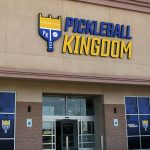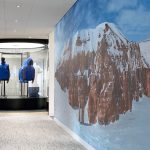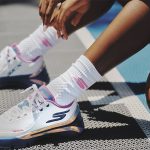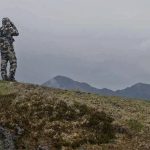After comparing last Februarys WSA show with a ghost town and characterizing the August event as more of a close-out inventory reverse auction than a trade show, we were pleasantly surprised to see the great energy coming from upbeat retailers and reinvigorated brand marketers at this years event held last week in Las Vegas.
The traffic at the show, which was again split between the Sands and Mandalay Bay, was still noticeably slower than in years past, but was a bit healthier than the last two events. In fact, we think a number of the brands that made the decision to take suites at the Venetian and skip the show floor may have missed out on some opportunities if they had a good story tell. The brands on the floor picked up some nice walk-up traffic that was impossible to capture hidden away in a suite selling closeouts.
A real turnaround at retail is credited for much of the energy, as department stores and the mid-market start to see some of the upside seen at specialty in the fourth quarter. The calendar year has certainly started off strong.
The aisles were also abuzz with the usual chatter about the issues that arent displayed front and center at the show, but nonetheless affect business — or people — in the industry. Key items of conversation centered around the impact of Footstars Thursday announcement — or threat — of bankruptcy, the potential for another Foot Locker faux pas in its budding tiff with K-Swiss, the ongoing Just for Feet probe and the number of people still yet to be affected, and the recent management upheaval at the Reebok brand. These topics appeared to capture the imagination of many at the show rather than any “must have” new product trend or brand.
Still, Sports Executive Weekly saw aisles — and most booths — that were much healthier this time around in a number of ways.
First, while aisle traffic worried some early on Day One, the quality and energy of the retailer left a lasting impression for many. Every vendor SEW spoke with was thrilled with the people they saw and the business conducted at the show. It was clearly a “quality, not quantity” story as vendors reported strong meetings with every major account, most regionals and quite a few of the independents from the West Coast.
Secondly, heavy inventories did not appear to be among the main topics of conversations as it gave way to talk about the resurgence of performance, strong early Spring sell-throughs, larger volumes of at-once or fill-in orders, and the favorable prospect for a sustained retail recovery.
And lastly, there was little talk of “the death of retro” as vendors pulled a wide range of fresh new looks from the bag that may have a retailer thinking twice how they buy goods for Fall/Holiday.
We also saw a real effort by the vendors to define their brands in narrower, more concise, terms. There was also a theme throughout the show that vendors were focusing more on building business within their current account base rather than aggressively adding customers. The exception to that rule is exemplified by a number of brands going after the running specialty market, which has been the focus for many to build a performance business.
We found the most buzz around the K-Swiss booth, with retailers indicating that they are more than willing to take in any inventory freed up as Foot Locker appears to back the off the brand a bit going into Q2. SEW searched the far corners of the show floor to find someone, anyone, that saw a softening in the brand, but we found nothing but enthusiastic supporters of continued K-Swiss growth.
Still, we did find vendors close to the Foot Locker situation that intimated that “cancels were coming” for K-Swiss and they hoped to pick up some open-to-buy from Foot while retailers were looking for open-to-sell. As we reported in SEW_0405, Foot Locker futures with K-Swiss were down 4% at year-end. By our estimation, that would indicate that the futures business with all other retailers was up more than 43% at the end of the year. Curious, no?
A number of people familiar with the situation point to the new K-Swiss allocation of its Classic shoe, which they felt was getting over-exposed in the market. The company announced in the fall that they were limiting 2004 retail purchases of that style to each retailers 2003 levels in an effort to curb promotion of the product. From K-Swiss standpoint, the effort appears to be working as sales of the Black Classic now make up 15% of total business.
We sat down with Steven Nichols, KSWS chairman and CEO, and tried to get his take on the situation. He was very gracious in his appraisal of FLs position, insisting that K-Swiss “has a wonderful relationship” with the retailer.
For their part, a key spokesperson for Foot Locker reiterated that same sentiment, describing the K-Swiss relationship as “very strong”.
Nichols was able to give us a bit more color on the business, indicating that “growth is sustainable”. In reference to retailers reaction to the allocation program, he said “mostly they dont like it, but they understand”, in part because they “enjoy better margins” with K-Swiss than other brands. He also pointed to the fact that K-Swiss isnt in the mid-market department store channel, which also keeps the brand above the promotional fray. The stand by KSWS reduced sales of the Classic by 30% in the fourth quarter.
One other reason for the continued energy is the ability for the company to re-invent and expand the Classics offering. The new Ramli, which is just hitting retail in six colors, is expected to do exceptionally well. The design takes color and interesting materials very well and will probably end up as one of the new Classic staples.
K-Swiss also see continued growth in Europe, where they positioned the brand as performance tennis for the first eight years of their effort there. Now in the region for ten years, Nichols said that the Classics backlog at year-end was up 60%, with Foot Locker Europe leading the way for much of the brand growth there.
Timberland was the other brand doing some great new product. The new Merge shoe, which is billed as a cross between a boot and a sneaker, is a strong commercial product that feeds the nascent urban outdoor sneaker market. Some likened it to an outdoor-influenced Air Force 1. The company isnt billing it as an urban product, but defines the shoe as “seasonally appropriate outdoor footwear”. It is clearly a strong first attempt at building a better year round footwear business here. You know its a winner when it gets knocked off before it hits the market (i.e. – FUBU).
One of the strengths at Timberland is their ability to look different in various channels in the same mall. The company feels that the segmentation strategy, based on the wide range of product groups, each with its own positioning strategy, is important to the retailer.
The company has really focused its efforts on its Smart Casual system, which features products with a contoured last, an outsole and footbed that expand, and a stretchable upper that all adjust to fit a consumers foot. The positioning for this platform is specialty independents and department stores. One of the key products here is the Torrance boot series, which the company said is one of their fastest-selling products at retail. The other key item is the Palomas, a $90 waterproof boot that should set new benchmarks on pricing.
On the Outdoor specialty side, Jay Steere has done an outstanding job leading the reorganization of the brand in outdoor recreation that reflects a focus on product for use from “summit to sea”. The brand is using a concept called Agile IQ for more active comfort that features contoured lasts, more substantial support, and increased traction on the outsole. One of the key products here is the Fastpack Expedite Low, which was named “Best of Show” coming out of the Outdoor Retailer Winter Market. Other key items include the White Ledge, another fully waterproof product at $90 and the Mont Cham series that features Approach products that are designed to go from “street to trailhead” and others that go from “trailhead to summit”. The series has two shoes with similar looks with tweaks in materials and technology to address the needs of the active user both on and off the mountain.
As we reported after the Outdoor Retailer Winter Market, Keen Footwear went out of their way last summer to stress that they were not another “sandal brand”. They wont have to do much talking about it this year as we were treated to some of the most innovative footwear product we have seen since Merrell launched the Jungle Moc. Keens strong attempt at an Outdoor Sneaker looked to us what a Converse All-Star might look like with a rugged outsole and black leather.
Keen president Angel Martinez has clearly been busy here with new product for Fall 04, but he also gave us feedback on great initial sell-through on the sandal product that delivered in November.
Puma went with a much bigger presence that really marked its move into a new phase of their growth in the U.S. Inside, the booth was all about the brand story as separate rooms reflected the brands segmentation strategy. The booth had a “list room”, which was cordoned off by a red velvet rope chain, featuring “more conceptual” limited edition product that is positioned for roughly 30 boutique rooftops in the U.S. Puma had enough room for some of their licensees that were showing everything from watches to thongs to complete the brand story.
The segmentation strategy appears to be working on all cylinders now as the company is finding ways to feed the athletic specialty channel while keeping a good pipeline of exclusive brand aspirational product for the “fashionistas” and “sneaker freaks” that frequent the boutique retailer. Each channel now has a “hero” product to drive sales.
Sales VP Tom Morgan said he was “thrilled” with the brands efforts on the performance end of the spectrum as well. Puma has tapped 45 of the top 100 running specialty to carry the improved running line. The company is investing more in this area after expanding Matt Lancors role to manage the running business and hiring two run specialty reps to service the business.
Perhaps the most unique idea we discovered at Puma was their use of a “six-act play” for key account sales presentations. The “play” reflects a “day in the life” of a Puma consumer and covers the activities of that consumer from school to work to sports to the nightclub and more. The “play” helps the company land the concept of consumers as multi-dimensional and multi-need rather than single-use shoppers. The selling concept should make other brands sit up and take notice as they attempt to capture more consumer dollars from their current base of business.
At Reebok, the lack of Terry Tate ads this year kept the aisle around the booth bit more subdued, which appeared to reflect less excitement about the brand. But it was inside that counted though as the company continues to execute against its three primary strategies of Rbk, Classics and Vector.
The coming year promises to be all about landing the vector, the logo developed ten years ago when Roberto Muller put his mark on the brand, as a performance icon it was originally intended to be. The exclusive league deals with the NFL and NBA are reportedly giving the brand tremendous cache from which to build and they must now ensure a steady stream of strong performance product to support the strategy.
The changes in senior management here, with corporate president and COO Jay Margolis consolidating his position over the Reebok brand, had many asking questions in the aisles. As SEW reported last week (SEW_0406), Reebok brand president & CEO Martin Coles resigned for “personal reasons.
Ron Wagenseil, Coles former Nike colleague and right hand at Reebok, exited the following day. The rumors for the changes ran from the mundane to the outrageous, with some even pointing to a recent Coles sighting at the Portland airport. Shocking!
What is apparent is that Margolis is focused on getting the Reebok brand strategy executed. Sources we spoke with inside the company saw the move as “very positive” and the move by Margolis as an effort to put more energy into the brand. Margolis will now have Dave Baxter and the apparel group, the footwear group, marketing, and all regional operating heads reporting directly to him, which is expected to streamline the process considerably. Insiders were also expecting a more refined and efficient decision-making process with Margolis leading the team.
The folks at Fila were downright giddy as they saw their efforts since the buyout start to bear fruit. Tom ORiordan, CEO for Fila USA, said that the show was one of the best hes had in ten years. He said one of the keys is the brands ability to tie footwear and apparel together by color. The booth was the only place we heard the term “hook-up” used, a concept that many abandoned as branded apparel sales suffered.
ORiordan also stressed the color story in their “authentic retro” product, which had terrific attention to detail with upgraded finishes and unique materials.
The company is also seeing efforts pay off on the performance side in basketball, soccer, training and tennis. The brand now claims the number three spot in soccer sales in the U.S., with the category growing 112% in the last year. They attribute much of the growth to the “fun factor” inherent in some of the boot designs, but also pointed to sharp price-points as drivers.
The company also announced during the show that Steve Wynne, the former CEO of adidas America, will join a number of people from his adidas team after accepting the position as president and CEO of Sports Brands International, Filas parent company. Robert Erb will join Wynne as well, becoming the companys chief marketing officer. Erb was most recently EVP of Global Marketing at TaylorMade-adidas golf and president of the adidas Golf Division.
Erb ran Sports Marketing at adidas when Wynne ran the Portland group. Wynne had gone back to his law practice after leaving adidas. Both will work out of SBIs New York City offices.
The good news here was coupled with more bad news for Jon Epstein, the former SBI/Fila CEO that led the buyout from the Italians. The Securities and Exchange Commission has filed suit against Epstein in the Just for Feet fraud case. Epstein in December entered a guilty plea in the ongoing criminal investigation that has claimed four industry vendor execs and two former JFF executives to-date .
The focus on performance, especially running, wasnt lost on the brands pitching technical running either.
Asics America said 2004 bookings are strong after seeing very little growth last year. Sales in 2003 inched up just 0.8% to $192.8 million after discount. But current year-to-date bookings are up almost 26% versus the same time last year. The trend may signal a base that is buying closer to need. Futures backlog, which was off at year-end, was up 8.4% at show time. Apparel sales were down 5.8% last year to 7.7% of the business. Apparel bookings this year are up 9.8% versus the year-to-date last year.
Rich Bourne, Asics America CEO, said they saw “good push numbers” from TSA, The Athletes Foot and Footaction. Bourne said that no one retailer represents 10% of the Asics business. He said the 2000 series and the Kuyana were “booking very strong”. SEW heard from others at the show that the 2090 is booking so strong that the company is “sold out” until May. Mr. Bourne said inventory levels are in “much better shape” than last year.
The trend business is also doing exceptionally well. Bourne said that Onisuka Tiger backlog was up 308% versus last year. He said the collection is “doing great” at Urban Outfitters.
Saucony said they “hit the reset button” last fall, with management there exclaiming “its been one hell of a year” in the tech channel. Countering the many pundits that were sounding the death of Retro, Anton Nistl, Sauconys VP for field sales, said they also have “more buzz” around the Jazz Original than they did last year. He pointed to Journeys as a key partner in the mall as they focus on more trend shops for placement this time around. Based on what we saw, SEW doubts we will see this product back in mass distribution again anytime soon.
Saucony is reporting numbers on Tuesday and based on the energy we saw in the booth, we expect to hear good things from the company this week.
Pearl Izumi continues their push into the footwear category, again focusing on perfecting the run category. The company has admitted that sell-through has been “mixed” and has pointed to some design issues that have been rectified for 2004. In fact, Pearl has made changes to its midsole and outsole tooling, which is not an inexpensive undertaking. The product apparently used to fit about a half size too short, but is now reportedly on the money.
The real push for these guys is their upper story. They are the only brand we saw that are telling the “seamless, welded” upper story as their key point of difference.
Pearl has a 50 store test at Foot Locker and has 10 stores at Galyans.
New Balance sees the market “edging” toward performance, while some of the retro stuff is waning, according to company president Jim Tompkins. Tompkins said NB has seen bookings up for 15 out of the last 18 weeks, and January deliveries were “tremendous”.
Tompkins said the company saw a “very difficult” spell in the March through July period last year, but July picked up nicely, leading to a “very strong” back half of the year. He said bookings “really started to roll” in September and just kept coming. Tompkins said that the industry had a “wake-up call” last year and the industry responded. He did confirm that business suffered in the mid-market, but said it was “coming back stronger now”.
He also said New Balance didnt really gain much from the “divorce” (NKE/FL), and hasnt seen any real impact from the reconciliation either.
Widths now make up about 50% of the business, which Jim said is “skewed a bit” by Classics. He said the widths business was only 20% to 25% of the business five years ago.
We also got a chance to sit down with John Morgan, who is now running the Basketball, Cleated, Cross-Training, Tennis and SMU businesses. Morgan said that the categories, especially the team sports products, will focus on fit (i.e. widths) in line with the overall company marketing position. He said the Tennis and Basketball business is “pretty small” right now and that Cross Training, while much larger, needs re-shaping and positioning.
He said Basketball has been “kind of” an item business and New Balance will be focusing on building a concept business focusing on the high school basketball player. He sees the brand becoming a “players shoe”, rather than the fashion route others have taken.
Morgan talked to SEW about the recent purchase of Warrior Lacrosse and the development of the Warrior lacrosse footwear shipping to retail now. The Warrior sales organization will sell the footwear to their existing accounts and New Balance reps will place the product in locations not currently served by Warrior. The shoes are built on a soccer last and will feature both mid and low cut shoes in black and white.
New Balance will launch Football product in 2005, where Morgan sees “big upside” in the widths business. Baseball is expected for 2006. Given the size of the kids coming out and into high school these days, the width conversation should be a natural play. The Cross-Training business will really be focused on the fitness end of the spectrum and is seen as a bit older than the Cleated consumer. Morgan said the target here is 25 years old and up and is looking at a broader range of activities, primarily in the gym.
Teva is poised to have a great year, based on talk in the aisles. New sandal looks have been well received and footwear is getting strong placement.
Deckers Teva business was overshadowed a bit at the show by sister brand Ugg, which has been all the rage this last winter. Deckers said they have made arrangements for enough sheepskin to exceed their guidance of $45 million for Ugg in 2004. They sold an estimated 600,000 pair of Ugg in 2003 and guidance would indicate 900,000 to a million pair is possible in 2004. While there were many knockoffs at the show, no other sheepskin boot maker had close to the energy that we saw at Ugg.
The Simple brand, which is part of the same business group as Ugg under Connie Rishwain, debuted a “Simple Sheep” product line that is a lower price-point Ugg-like style. The company tested the styles at Famous Footwear last year to strong results. DECK is also prepared to do first cost business on the hot sheepskin boot as well as in sandals.
Pro Keds had some of the best fashion product we saw at the show. Adding a new twist to the retro Original Royal, PK added a rubberized upper, Teflon coated laces and a gusseted tongue to launch the Royal Storm as a waterproof product for the back half of 2004. Color will also play a big part in this story as the Womens offering looks to be the stronger gender for the rubberized styles. The Royal Lightning takes the same profile sans the laces as a pull on “bootie”. Mens and Womens look to both do well here, going after sales of “ducks” style footwear from others.
Tommy Hilfiger is really stepping up the fashion play on athletics with its Lion Collection, which utilizes the new lion crest used on Hilfigers upper end line. The product looked phenomenal as the brand took traditional athletic silhouettes even cleats and tweaked them just enough to create a very dramatic line of product. In SEWs estimation, one of the biggest challenges that TH Footwear had was the insistence by Hilfiger Apparel on the use of the Tommy flag. The new lion crest now gives footwear licensee Stride Rite much more room to do some very interesting things.
Sof Sole may have shown us the future of footwear and accessory retailing with their new FitSys program. The company is committed to combining an insole sale with its new sock program and developed a FitSys scanner for retailers that will assess a consumers foot in-store in 30 seconds. The system then recommends the insole and sock that the user should purchase based on their foot structure, activity frequency and type, and other personal characteristics.
Sof Sole plans to have over 500 of these scanners in place by the end of the year. The system is similar to the one used by The Athletes Foot to make footwear recommendations in their stores. SEW sees the scanners as a highly educated sales clerk that doesnt cost the retailer anything and rarely needs a vendor tech clinic. Oh, and you dont have to buy them pizza and coke either.











